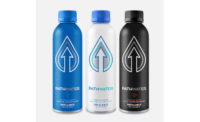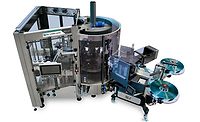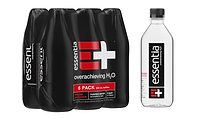![]()
Innovations in P.O.P.
by Laurie Russo
Beverage point-of-purchase suppliers have been hard at work
coming up with new ways to attract attention. Some are going with state-of-the-art,
and even futuristic, technology. Others are having fun with traditional designs
and materials — call it old-school with a twist. Either way, no one is standing
still.
“The beverage industry is becoming more
innovative and sophisticated in finding ways to advertise its products and
ideas,” offers Richard Scardino, president of Houston, Texas-based
Premier Merchandising. “The trend seems to be increasing for what I
would call mid-priced, wide-format printers and laminators to produce
in-house P.O.P. advertisements.” He cites the new Encad/Kodak 1000i
wide-format printer, which comes in 42-inch and 60-inch models and prints
up to 220 square feet per hour, as an example.
Another product Scardino is excited about is Premier's
own “Ad Roller,” which continuously rotates to display a
product or message in a vertical motion. “At the least, I think it is
a very innovative approach to getting a customer’s attention,”
he says. The Ad Roller also is affordable — the 24-inch model costs
$149 — and it's also available in 36-inch and 50-inch models.
Traditional materials are also being taken for a spin.
Stanton, Calif.'s Couch & Philippi, a silkscreen printer that
fabricates primarily (but not exclusively) on metal, points out that while
it has very traditional uses, it also has new, creative and flexible design
concepts. Tim Riordan, vice president of sales and marketing says,
“Although it's considered an old technique, it's seeing a real
resurgence. We're always trying to push the envelope as far as doing new
things with metal.”
Metal is a durable medium, he explains, and can be
embossed, die-cut and rolled into almost
any shape. “We have metal that's silver/ metallic, and we can use
different translucent inks that allow us to create a very colorful, vibrant
piece, but the metal still comes through, giving it a look you just can't
get with paper, plastic or cardboard.”
This durability and design flexibility is being put to
use on-premise at restaurant chain TGI Friday's, where table-toppers (used
to promote specialty drinks, for example), are
typically printed on paper products or plastics. The new C&P product is
clear, embossed aluminum printed with translucent inks using a four-color
process.
“This piece is not
only unique, but durable — paper, cardboard and plastic table-toppers
get too easily beat-up and last a month to six weeks, tops,” says
Riordan. “These not only last around three months, but the price is
competitive.”
Another favorite C&P piece is the 5-quart
promotional bucket, used by Anheuser-Busch for everything from holidays to
sports. “We did about 35 to 40 designs, or 150,000-200,000
buckets,” recalls Riordan. C&P also does work for Coors, but
microbrewers — such as Flying Fish and Tahoe Brewing — are not
left out. The company is happy to deliver smaller quantities.
May Advertising of Ft. Worth, Texas, is also big on
metal. The printer and fabricator is a longtime supplier to convenience
stores, and sees beverage companies moving into non-traditional pieces.
“We see companies such as Pepsi and Coke — clients of ours
— doing a lot more c-store advertising, and more outdoor pricing,
where most of it used to be indoors,” says Allan Meyer, May's vice
president. “Also, we're doing more permanent point of sale, like
five-year outdoor aluminum flip price signs, which can change from 12-pack
to 6-pack to 2-liter... they can save money in the long run.”
“Technology is making a bigger impact in the
marketplace. Everyone is looking for the newest thing to set them apart
from the competition,” he continues. “We still do a lot of the
metal beer tacker signs you often see in bars. But we've tried to offer
things like lighted signs, novelty signs... things that will grab people's
attention rather than just being stuck to a wall.”
One May piece that clearly grabs attention is the
floating beverage can and display. These pieces can turn, flip, float and
move with no strings, and can be encased or non-encased.
Another helpful trend for suppliers, offers Meyer, is
that beverages are going into non-traditional venues. “Office supply
stores that have never carried beverages now stock water and coffee, like
Starbucks in Staples,” he says. “This gives us opportunities
we've never had before to print P.O.P. items for companies that we work
with both directly and indirectly. For example, we did the printing for a
display company working for Starbucks, which then went into Staples
locations.”
Riverside Technologies, Wilton, Conn., produces on-
and in-package materials for companies such as Coca-Cola, Interbrew, Miller
and Coors, most on the cutting edge of technology. Cans that talk or
contain money are all part of the fun.
“Consumers are tired of the same old promotions
and have become non-believers in promotional and advertising
promises,” insists President Jin Howes. “Today's sophisticated
manufacturer creates a point of difference to grow market share by adding
value or a unique twist on the product benefits to compete in this very
competitive marketplace.”
Riverside's flagship product is a light-activated
talking sweepstakes mechanic which uses the customer's personalized
message. Talking cans or caps are randomly inserted into the product mix.
“When our talking can is opened by an unsuspecting consumer, that
consumer will hear up to a 32-second audio announcement (‘You've
Won!’ etc.),” explains Howes. A Dr Pepper Spider-Man Talking
Can is currently at retail.
Another Riverside mechanic is the cash/prize can for
soft drinks or beer — an instant prize or cash pops up through the
can's pouring opening. “With a cash prize,” Howes reminds,
“there are no fulfillment costs.”
May Advertising's Allan Meyer perhaps speaks for all of today's
beverage P.O.P. suppliers when he sums up by saying, “The majority of our growth
has come from innovative ideas, and being the first to our clients with those
ideas. Sometimes the client comes up with the idea, sometimes we present it
to them. But in the end, what helps the beverage companies grow is being the
first to present these new ideas into the marketplace.”


